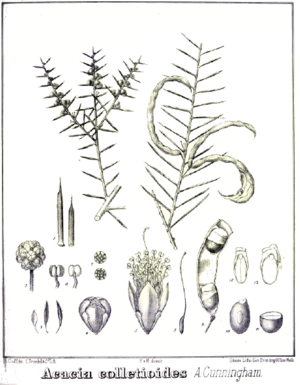Wait-a-while facts for kids
Quick facts for kids Wait-a-while |
|
|---|---|
 |
|
| Scientific classification | |
| Genus: |
Acacia
|
| Species: |
colletioides
|
 |
|
| Occurrence data from AVH | |
The Acacia colletioides, also known as wait-a-while, pin bush, or spine bush, is a type of shrub. It belongs to the Acacia plant family and is native to Australia. This plant is known for its prickly nature, which is how it gets its common names.
Contents
About the Wait-a-while Plant
This prickly shrub usually grows to be about 0.5 to 3 metres (2 to 10 ft) tall. Its branches are smooth or have only a few hairs. You can see scars on the branches where old leaves used to be.
The leaves of the wait-a-while plant are called phyllodes. These are not true leaves but flattened leaf stems that act like leaves. They are stiff, sharp, and smooth. They attach directly to the stem without a stalk. Each phyllode is usually 1.5 to 3 centimetres (0.59 to 1.18 in) long and 1 to 1.5 millimetres (0.039 to 0.059 in) wide. They can be straight or slightly curved.
Flowers and Seed Pods
The wait-a-while plant blooms in winter and spring, from July to September. It produces bright yellow flowers. These flowers grow in small, round or oval-shaped clusters. Each cluster has about 15 to 24 tiny flowers. The flower heads are small, about 3 to 5 mm (0.118 to 0.197 in) across.
After the flowers bloom, long, coiled seed pods start to form. These pods can grow up to 7 cm (2.76 in) long and 3 to 5 mm (0.118 to 0.197 in) wide. Inside the pods are shiny black seeds. The seeds are oval-shaped and about 3 to 4.5 mm (0.118 to 0.177 in) long. Each seed has a bright orange or yellow part called an aril, which helps with seed dispersal.
How the Wait-a-while Plant Got Its Name
The scientific name for plants and animals is called their taxonomy. This helps scientists organize and understand living things. The Acacia colletioides was first officially described in 1842 by a botanist named George Bentham. He wrote about it in a scientific journal.
Later, in 2003, another botanist, Leslie Pedley, reclassified it. This means he changed its scientific name for a while to Racosperma colletioides. But in 2006, it was changed back to its original name, Acacia colletioides.
This plant is closely related to another plant called Acacia nyssophylla. It also looks similar to other Acacia species like Acacia asepala, Acacia subsessilis, and Acacia enterocarpa.
Where the Wait-a-while Plant Grows
The wait-a-while plant is found in dry parts of Australia. You can see it from the west coast of Western Australia, through parts of South Australia, and into north-western Victoria. It also grows near Dubbo in New South Wales.
It often grows in areas called mallee scrub or open woodland communities. These are places with many small, multi-stemmed trees and shrubs.
Specific Locations in Australia
In Western Australia, this plant is found in regions like the Wheatbelt, Mid West, and Goldfields-Esperance. It can grow in many different types of soil there.
In Victoria, it grows in specific areas like the Murray mallee and the Lowan mallee. Here, it prefers sandy loam soils and is mostly found in the north-west of the state.

